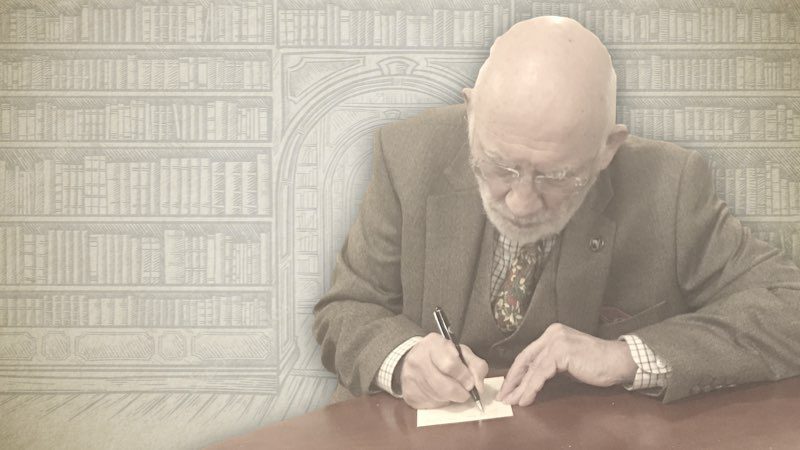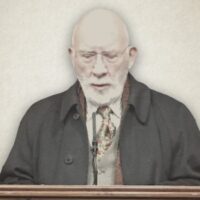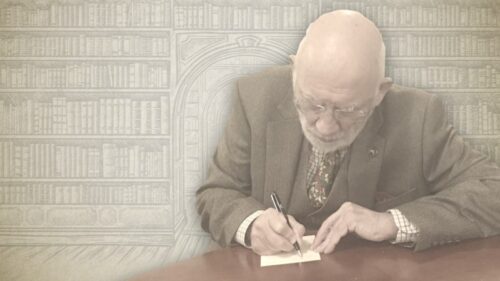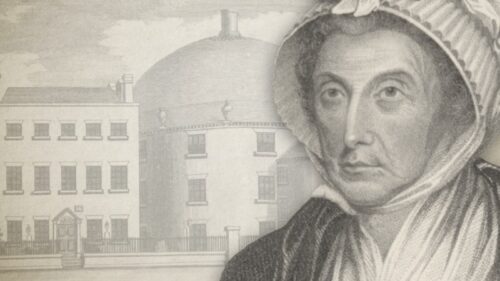
Gerhard Tersteegen (1697-1769): Poet of Eternity
[Posted With Permission, Peter Meney Of “New Focus“]
TERSTEEGEN’S WRITTEN WORKS
Gerhard Tersteegen is best known to English-speaking Christians through his hymns translated by Emma Francis Bevan, Francis Elizabeth Cox, William Delamotte, Sarah Findlater (with her sister Jane Borthwick), Melanchthon Woolsey Stryker, John Wesley and Catherine Winkworth. Most of these translation are, as Lady Durand confesses concerning her own renderings of Tersteegen, ‘imitations’ rather than translations and the numerous Tersteegen hymns to be found in English often lack the plaintive mourning of the poet over his sin, his sweet serenity in contemplating his salvation and his deep inward joy in believing. Tersteegen is now chiefly known for his poetry and hymns but in his own day, it was his preaching that moved men most. Emily Chisholm and Samuel Jackson have made some of Tersteegen’s sermons and letters available in English but the bulk still awaits translation. His earliest work was a treatise on Reformed doctrine and Tersteegen, a skilled linguist, trained in French, Dutch, German, Latin, Hebrew and Greek, produced translation after translation of Reformed, Lutheran and Free Church literature, but he also wrote numerous devotional works which received international praise. I love Tersteegen for the insight he gives us into the eternal mind of God and His plans for His people. When multi-linguist Tersteegen was asked which country he was from, he invariably answered, ‘My home is with God in Eternity’.
F. W. KRUMMACHER DEFENDS TERSTEEGEN
Sadly, the name of Tersteegen has become synonymous amongst his critics with an exaggerated Quietism and an escapisim from the natural order of the world to one of mere spiritual truths void of anchorage in the Christian’s everyday life in Church and State. F. W. Krummacher (1796-1868) was born in the same town of Moers and served as a minister in ‘Tersteegen Territory’ (Ruhrort) and rejects such an accusation, saying:
From this tendency, which was certainly unhealthful, and for which it would be a crying injustice to make the noble Tersteegen responsible, the faithful at Ruhrort ought to have had intelligence enough to have kept themselves freer. Tersteegen was their favourite and constant guide and adviser in the narrow way. His ‘Crumbs’ constituted, the whole year through, the principle foundation of their household devotion, and the precious songs of his imperishable Garden of Spiritual Flowers (Geistes Blumengärtlein) lived continually in their mouths and in their hearts.
Krummacher relates that Tersteegen’s ‘brooks and cisterns of gospel truths’ turned those to whom he ministered to ‘the living fountain, the Word of God itself.’
EXCELLENT FACILITIES TO STUDY TERSTEEGEN AVAILABLE
Hundreds of Tersteegen’s works are extant and many letters from his pen have been rediscovered recently. Tersteegen’s fine house in the center of Mülheim has been preserved and is now a museum depicting his life and background. A number of Tersteegen’s artifacts and documents are placed under the care of the Mülheim Historical Society and its members assist in the care of the Tersteegen Museum and City Archives and serve as guides for visitors. The Society also provides library and archive facilities for research into the life of Tersteegen and the Mülheim Public Library has also a good selection of works on Tersteegen for public use.
TERSTEEGEN’S BIRTH AND EARLY YEARS
Gerhard Tersteegen was born into the wealthy merchant family of Henricus and Conera Ter Steegen (née Triboler) on 25 November 1697. Conera bore Henricus eight children, two daughters and six sons, of which Gerhard was the second youngest. Five of the boys, including Gerhard, became merchants and one, Jodokus, became a minister of the Reformed faith. Gerhard’s sister, Johanna, married Matthias Brink, a merchant who taught Gerhard the business. Gerhard is named Gerardus in the Moers Church Baptismal Register of 1. 12. 1697, but our subject was always called Gerhard or Gerrit. It is difficult to say of what nationality the Tersteegens were as Moers was a sovereign state under the dukes of Walburgis. However, the French traditionally claimed Moers as their own together with large parts of the Netherlands. When the male lineage died out in 1594, Countess Walburgis gave her county to Prince Maurice of Orange. His successor, King William IV of England, died in 1702 and in the ensuing war, Prussia took over Moers but lost it to France from time to time. As Moers was in the hands of the Orange family at the time of Tersteegen’s birth, the Dutch proudly claim Tersteegen as a Dutchman.
Gerhard’s father, a pious member of the Reformed Church, died when Gerhard was six years of age but his mother Conera, managed to send him to the elite Adolfinum Grammar School where the emphasis was on learning foreign languages because of Moers’ international role. The Heidelberg Catechism was taught in Latin and German and the Bible was studied in Hebrew and Greek. Each pupil had to convert the Sunday sermon into verse and be prepared to recite and expound it publicly. When Gerhard left the school shortly before his sixteenth birthday, he was chosen to give the annual students’ speech in Latin verse of his own composition. Gerhard’s teachers, school governors and city councilmen all promised Gerhard a university scholarship but Conera rejected all such offers. Her son was to become a merchant like his father and older brothers.
TERSTEEGEN COMES TO MÜLHEIM
Exactly when Tersteegen settled down in Mülheim on the Ruhr, nobody knows. The traditional date given is 1713 but the Moers church books record that Gerhard gave his confession of faith before the Moers’ congregation at Witsuntide, 1715, thus officially becoming a church member. Such a ceremony was performed after a period of catechising lasting at least two years, so Gerhard was most likely still living in Moers at the time. Given the distance between Moers and Mülheim and the fact that Gerhard says he made such journeys on foot during his apprenticeship, it would have been quite impossible for the young boy to have attended the catechising lessons. However, Gerhard was certainly in Mülheim by 1715, if not before.
Today, Mülheim, on both banks of the River Ruhr, is a small nondescript town; a deficit made good by the beautiful countryside around it. However, in the 1660s, Mülheim made history by becoming the birthplace of German pietism and from within the town’s boundaries a great revival spread along the Ruhr which flooded over into the whole of Germany, Holland, Switzerland and Russia and finally into the USA. Theodore Freylinghausen, for instance, a major pioneer of the Great Awakening in North America, found Christ within the movement set in motion in Mülheim. The movement commenced through the ministry of Reformed Pastor Theodore Undereyck (1635-1693), who had studied under Voetius, Cocceijus (Koch), Essen, Labardie, Perkins and Ames, and who organised home meetings after the Sunday services so that his parishioners could discuss what they had learnt. These house meetings became increasingly popular and the idea spread throughout Germany and Holland and soon both Reformed ministers such as Joachim Neander and Lutherans such as Philip Jacob Spener and August Hermann Franke visited Mülheim to learn of the work of grace that was taking place. Undereyck’s outreach was then reduplicated in Hamburg, Bremen, Düsseldorf, Halle and parts of Holland. German Reformed pietism was thus strong some ten years before the Lutherans began a similar work. Such work had been continuing for some 45 years before Gerhard came to Mülheim.
THE PIETISM PREVAILING IN MÜLHEIM
At this time, a minister of the Reformed Church Wilhelm Hoffmann had left the paid parish ministry of the Reformed Church and set himself up as an itinerant preacher. Soon Gerhard was to come under Hoffmann’s influence and eventually become his successor. Gerhard, however, never broke with the established church as did Hoffmann. Hoffmann and his followers were strongly influenced by Quietists such as Madame de la Motte Guyon and Mystics such as Jacob Böhme and young Gerhard began to read their works. Though he respected these authors all his life, he found their absolute denial of themselves and the world too much of a denial of God’s grace in human creatures. The way of holiness seen through the works of de la Motte Guyon and Böhme seemed to be an unending struggle over oneself by oneself and in his efforts to become righteous, Tersteegen found himself in a long, dark tunnel. He worked hard at learning his trade but in his leisure time, he isolated himself from all company and studied the Bible, Pietistic and Quietist books. He resolved to live a life fully in obedience to God. Many call this Tersteegen’s conversion but it was the mere beginning of a seven year period before he received not only an awareness of the truth but the inner liberty which comes from becoming a true child of God’s. As soon as Tersteegen finished his apprenticeship, he founded his own business but after two years, he gave it up and withdrew almost totally from the world, rejecting even tea and coffee as luxuries and existing on one scanty meal a day. Soon he became penniless, so he strove to earn a little through weaving linen but he was now too weak to work. Happily, Tersteegen began to look away from the God who is merely discoverable on the wings of the wind and in the depths of inward meditation and gave Böhme’s books back to their owners. Then Tersteegen, left with only his Bible, discovered the love of God in Christ. Experts say this was Tersteegen’s second conversion. It was actually his first and the only conversion necessary. Tersteegen’s dark and dismal struggle which had lasted until Easter, 1724 was now replaced by a spiritual sight of the Sun of Righteousness with healing in His wings. His first-known poem after this liberating experience testifies to his consciousness of and repentance of his sin and of his then enjoying peace with God. Hereafter, the poetry, hymns and prose reflect practical Christianity in a Christ-filled life.
To emphasise his break with inward-looking gloom and his experience of the Sun of Righteousness, Terstegeen dedicated his life to God in a manner he was to repeat each Eastertide. Many 18th century divines such as Doddridge and Newton thus recorded their anniversary experiences but Terstegeegen wrote these anniversary testimonies in prose and poetry in his own blood. Only last year, such a document was presented to Mülheim’s Tersteegen Museum. It had been kept in a private family since Tersteegen’s day. Tersteegen imitators are most numerous but such remnants of Tersteegen’s more Quietistic past can be proved to be genuine or not by a simple laboratory test. Tersteegen claimed that if his writing in his own blood led people to Christ, he was prepared to empty his veins for them.
TERSTEEGEN THE CHRISTIAN ACTIVIST
Now Tersteegen entered into the active life of the Christian. He set up a private school, principally for the children of his brothers and sisters and composed textbooks of instruction for them, including a catechism of Christian doctrine. In 1725, Tersteegen decided to learn band-weaving as a means of earning a living, so he invited Heinrich Sommer to come and live with him and teach him the trade. For two or three years the two men breakfasted together and then began work from six in the morning until eleven. They then separated for a period of private prayer and Bible study and then worked from 1 to 6 p.m. at their trade. During the evenings, Tersteegen studied the Bible and began compositions for his now famous Little Flower Garden. Hoffman gradually persuaded Tersteegen to allow himself small luxuries such as decent food and clothing and was pleased to see that Tersteegen was willing and able to help him in his weekend preaching. This took more and more of Tersteegen’s time, so his band-weaving was quickly abandoned. Between 1725 and 1727 a great awakening took place in the Ruhr District in which Tersteegen became a leading evangelist and wealthy merchant friends in Mülheim built a conventicle hall for the converts. During this period, Tersteegen produced one book after the other in rapid succession. Sadly, a number of new converts began to believe that as they were no longer under the law, they could live a sinful life without fear of eternal punishment. This moved Tersteegen to write a book on the relationship of law and grace and the believer’s duty to live a life of edification and practical righteousness. By 1727, Tersteegen was a full-time preacher. However, shocked by the poverty and diseases rampant amongst his hearers, he began to learn the trade of a Chemist and turned one of the rooms of his house into an apothecary’s laboratory, daily mixing portions for his sick hearers who, of course, received their medicine free of charge. Soon, he was able to employ an assistant to help with this work and also a housekeeper, Sybille Emschermann, known lovingly by the Tersteegenites as ‘Billeken’. Mrs Emescherman was given the entire ground floor of Terstegen’s house for her work, assisted by her brother and his wife, in feeding the numerous poor who visited Tersteegen’s home daily.
Now Tersteegen took to the highways and byways holding meetings in the open air. In keeping with the widespread caritative movement at the time to found houses for the unemployed and poor and provide work for them, friends of Tersteegen in nearby Heiligenhaus and Saarn set up a Gemeinschaftshaus (Community House) under his leadership where poor converts were fed and taught the weaving trade and lived in prayer and fellowship with one another. The large domicile at Heiligenhaus is now also a Museum and houses furniture and books belonging to the preacher. By this time, Tersteegen was nationally and international renowned and from around 1730 visited various parts of Germany and Holland regularly and at least one Dutch writer claims Tersteegen visited Denmark and Sweden.
CRITICISM OF TERSTEEGEN’S PIETY
Tersteegen’s blood-letters have caused Reformed writers to view Tersteegen warily but the fact that the Reformed pietist worked for twenty years on a large two-volumed collection of biographies of Roman Catholic saints of old has caused many to turn from him altogether. However, Tersteegen emphasised that God had his witnesses in all places and times and it would be foolishness to believe that history before the arise of the Reformed churches had been totally void of Christian witness. Tersteegen claimed that he was moved to write the volumes because so many converts were misunderstanding Christian doctrine but nobody could misunderstand the work of God in his living epistles in history. Terstegen emphasised that though he was Reformed in his theology, he was not a denominationalist and recognised the work of God in the lives of men and women from other countries and confessional backgrounds. The Roman Catholics, however, took Tersteegen’s work as an insult and a false attempt to show the antiquity of the Protestant, evangelical faith. They protested against Tersteegen’s preachers and had several imprisoned on the grounds that the laws allowed for Roman Catholic, Lutheran and Reformed preaching but not for conventicles. The Landesregierung (state government) agreed with the Roman Catholics and on 28 June, 1740 all conventicles were forbidden. For ten years, Tersteegen was not allowed to preach in public, so whilst ministering privately to the ‘quiet in the land’ in Mülheim he preached to great congregations in nearby Holland.
A NEW REVIVAL COMES TO MÜLHEIM
In 1750, however, a new revival visited Germany from Holland and Mülheim once again became a centre of spiritual activity. Though initially the leader was a young student of theology from Duisburg, Jacob Chevalier, all clamoured for Tersteegen to preach again in the town. In December, 1750, Tersteegen once again preached the Word of God in Mülheim before hundreds of hearers. At once the three Reformed pastors in the city protested and demanded Tersteegen’s arrest. However, the Lord Mayor had become a friend of the revival and refused to take action. Tersteegen urged the Reformed pastors to join the revival movement and see their churches full of worshippers. Chevalier began to demand a fixed wage for his preaching so Tersteegen, who never asked for a penny (but often received pounds) felt he had to separate from him. Chevalier became a minister in Wijnjeterp, Friesland with a set income and remained closely in touch with Tersteegen. As Tersteegen’s preaching became more and more popular the Reformed pastors appealed to the courts but the judges refused to listen to them. Public opinion was for the revival. Now, every morning Mülheim citizens from all ranks and walks of life met outside Tersteegen’s house to listen to him preach through the open window.
THE SEVEN YEARS’ WAR
Tersteegen continued to preach and teach daily from early morn till night and in 1756 his health broke. Now both France and Austria laid claims on the Ruhr District and the Seven Years war began between Prussia, Austria and France. Soldiers of all three armies were encamped around Mülheim which remained the centre of the battles for the entire period of the war. Friends urged Tersteegen to flee to Holland but he remained at his post. The French began to drive the Prussians back and took over Broich, Speldorf and Saarn on the southern bank of the Ruhr. Tersteegen was forced to billet Prussian officers, soldiers and horses in his home, only to have them replaced by their French counterparts when they gained the overhand. The French were delighted at Tersteegen’s linguistic abilities and selfless hospitality and left him with a letter of grateful thanks instead of plundering his home. Elsewhere they plundered and killed their ‘hosts’. Once Tersteegen was stopped on his way to Duisburg by French troops who ordered him in the devil’s name to dismount. Tersteegen shouted that the devil could not command him and galloped past and the cavalry who pursued him could not catch him. The French, however, eventually plundered the entire town of Mülheim, conscripted the young men into their army and dismantled and carried off everything that was moveable, including the coal ships which was the cities main source of income. Tersteegen saw the war as God’s judgement on a nation that was departing from Reformation truths.
TERSTEEGEN’S HOMECALL
By 1564, Tersteegen was broken in body though not in spirit. He found that though he could not travel, he was visited daily by people who had journeyed many miles to hear a few words from his lips. A severe cough and breathing difficulties made such preaching from his bed more and more difficult. Then Tersteegen’s kidneys began to fail, gout set in and he was burdened with a severe hernia. On 9 February, Tersteegen wrote his testament which reads more like a sermon than a disposal of earthly possessions as he expresses his great thanks to God for all his mercies and outlines his faith and his trust in God’s Word. He closed his will with the words:
In child-like, humble trust in the divine mercy of Christ, I now trust in and await that when my eyes close and others pronounce me dead, I shall at last enter into eternal life and be for ever with my Lord.
A few days later, Tersteegen’s pains increased and he suffered from convulsions and oedema. He had no bodily peace in death as a long stream of visitors passed daily by his couch to gain a last word from the praise that was continually on his lips. Soon, the only audible words which they heard were, ‘O Jesus, sweet Jesus!’ At 2 o’clock in the morning, 3 April 1769, Gerhard Tersteegen fell asleep on earth to be awakened in Heaven.
The repose in Christ which Tersteegen found is best summed up in his hymn on the subject translated into English by John Wesley:
REPOSING IN THEE
Thou hidden love of God, whose height,
Whose depth unfathomed, no man knows,
I see from far Thy beauteous light,
And inly sigh for Thy repose;
My heart is pained, nor can it be
At rest till it finds rest in Thee.
What is there more that hinders me
From ent’ring to Thy promised rest
Abiding there substantially,
And being permanently blest?
O Love, my inmost soul expose,
And every hindrance now disclose!
Is there a thing beneath the sun,
That strives with Thee my heart to share?
Ah, tear it thence, and reign alone,
The Lord of every motion there!
Then shall my heart from earth be free,
When it hath found repose in Thee.
Tell me, O God! if aught there be
Of self, that wills not Thy control;
Reveal whate’er impurity
May still be lurking in my soul!
To reach Thy rest and share Thy throne,
Mine eye must look to Thee alone.
O love Thy sovereign aid impart,
To save me from low-thoughted care;
Chase this self-will from all my heart,
From all its hidden mazes there;
Make me Thy duteous child, that I
Ceaseless may, ‘Abba Father,’ cry.
Ah no! I would not backward turn;
Thine wholly, Thine alone I am!
Thrice happy he, who views with scorn
Earth’s toys, for Thee his constant flame!
O keep, that I may never move,
From the blest footsteps of Thy love!
Each moment draw from earth away,
My heart, that lowly waits Thy call;
Speak to my inmost soul, and say,
‘I am thy Love, thy God, thy All!’
To feel Thy power, to hear Thy voice,
To taste Thy love, be all my choice.
George M. Ella, born February 1939 in Yorkshire, England, has lived most of his life on the European Continent. He is a retired Senior Civil Servant formerly employed in teaching, post-graduate teacher-training, chairing examination boards and curricula work. He holds degrees from London, Hull, Uppsala, Essen, Duisburg and Marburg universities with doctorates in English Literature and Theology. Dr. Ella has written regularly since the seventies for a number of magazines and newspapers and published numerous books on Church History, including biographies of William Cowper, William Huntington, James Hervey, John Gill, Augustus Montague Toplady, Isaac McCoy and Henry Bullinger besides works on doctrine and education. He is currently finishing the third volume of his series 'Mountain Movers'; a biography of John Durie; a work on Law and Gospel and further study material for the Martin Bucer Seminar. Dr. Ella is still internationally active as a lecturer and is a Vice-President of the Protestant Reformation Society. He is keenly interested in missionary work and has written on the spread of the Gospel amongst the Same people of Lapland, the people of India and the Native Americans. This present volume follows Dr. Ella's 'The Covenant of Grace and Christian Baptism', also published by the Martin Bucer Seminar. George Ella is married to Erika Ella, nee Fleischman, a former government administrator, and they have two sons Mark (41), Director of a Polytechnic College in Bremerhaven and Robin (39), Leading Senior Physician in a newly-built Geriatric and Psychiatric clinic in Dessau.
George Ella on Doctrinal Matters
George Ella's Biographical Sketches





